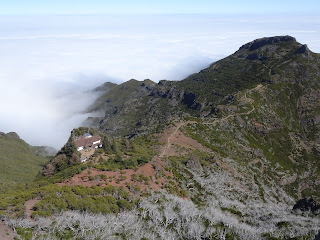Reviewing our stay in Madeira, I wish I had packed more shorts and less long pants. The predicted weather forecast was highs in the upper 60's, but for several days, a strong wind off the Sahara desert blew westward to Madeira raising the temperatures to the mid 70's. I thought that we would encounter cooler temperatures at altitude, but with the sun shining above the clouds (4500'+), it was often warmer at altitude than near the coast. We had one day of rain; we used that day to visit the old town part of Funchal.
View from our hotel balcony in Ponta Delgada. Go one block, turn right, and you are at a yummy ice cream shop.
After a long walk, we are at the east end of the harbor promenade. A gray volcanic sand beach is in the distance.
Now we are at Ponta Delgada, the Azores, only a two-hour flight on our first hop homeward. We are staying in a boutique hotel we enjoyed previously, and, after a long walk along the harbor front, we found our way to a restaurant for dinner and an ice cream shop (sorbet for me) both of which we had previously enjoyed here. We like to break our flights up into shorter segments and avoid long days on an aircraft when we can. Will we come again?.... This is our third time stopping at Ponta Delgada. This visit we discovered that beautiful parks Jardim Antonio Borges, the Presidential Residence, and Jardim Botanico are not far from where we are staying; discovered while we were on our almost daily long walk.
Lush vegetation with many very large trees; this tree is only notable for the tree moss; size-wise not notable.
An armed guard and security check were present at the entrance to the presidential grounds. We were also required to stay on a designated path while walking the area.
Look at the size of that bamboo. Tiny little Dawn (in comparison) is walking the path on the right side.
We invited our new friend, Fabricio, to visit us in Colorado; with he and his wife saving for a house, the travel expense for them may be excessive. He did say that he will invite us to dinner at their apartment if we visit Madeira again. The people we have met are so enjoyable! We flew out of Madeira on February 29; March 1st they started quarantine for incoming tourists and then completely closed the airport. Tourism is expected to be suspended until at least July.
Now we go home to shoveling snow, doing income taxes, and renovating our master bathroom. Ugh! Also time to renew our passports ASAP!
View from our hotel balcony in Ponta Delgada. Go one block, turn right, and you are at a yummy ice cream shop.
After a long walk, we are at the east end of the harbor promenade. A gray volcanic sand beach is in the distance.
Now we are at Ponta Delgada, the Azores, only a two-hour flight on our first hop homeward. We are staying in a boutique hotel we enjoyed previously, and, after a long walk along the harbor front, we found our way to a restaurant for dinner and an ice cream shop (sorbet for me) both of which we had previously enjoyed here. We like to break our flights up into shorter segments and avoid long days on an aircraft when we can. Will we come again?.... This is our third time stopping at Ponta Delgada. This visit we discovered that beautiful parks Jardim Antonio Borges, the Presidential Residence, and Jardim Botanico are not far from where we are staying; discovered while we were on our almost daily long walk.
Lush vegetation with many very large trees; this tree is only notable for the tree moss; size-wise not notable.
An armed guard and security check were present at the entrance to the presidential grounds. We were also required to stay on a designated path while walking the area.
Look at the size of that bamboo. Tiny little Dawn (in comparison) is walking the path on the right side.
We invited our new friend, Fabricio, to visit us in Colorado; with he and his wife saving for a house, the travel expense for them may be excessive. He did say that he will invite us to dinner at their apartment if we visit Madeira again. The people we have met are so enjoyable! We flew out of Madeira on February 29; March 1st they started quarantine for incoming tourists and then completely closed the airport. Tourism is expected to be suspended until at least July.
Now we go home to shoveling snow, doing income taxes, and renovating our master bathroom. Ugh! Also time to renew our passports ASAP!


































